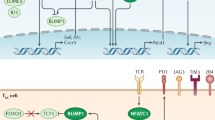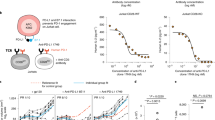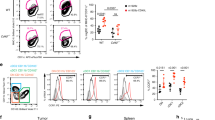Abstract
Protective cell-mediated immune responses in cancer are critically dependent on T-helper type 1 (TH1) cytokines such as interferon-γ (IFN-γ). We have previously shown that the combination of CD40 stimulation and interleukin-2 (IL-2) leads to synergistic antitumor responses in several models of advanced metastatic disease. We now report that after this treatment and other immunotherapy regimens, the CD4+ T-cell population, in contrast to CD8+ T cells, did not significantly increase but rather exhibited a substantial level of apoptosis that was dependent on IFN-γ. Mice immunized with tumor cells and treated with an immunotherapy regimen that was initially protective were later unable to mount effective memory responses compared with immunized mice not receiving immunotherapy. Immunotherapy given to tumor-bearing Ifngr−/− mice resulted in restoration of secondary responses. Thus, although immunotherapeutic regimens inducing strong IFN-γ responses can lead to successful early antitumor efficacy, they may also impair the development of durable antitumor responses.
This is a preview of subscription content, access via your institution
Access options
Subscribe to this journal
Receive 12 print issues and online access
$209.00 per year
only $17.42 per issue
Buy this article
- Purchase on Springer Link
- Instant access to full article PDF
Prices may be subject to local taxes which are calculated during checkout






Similar content being viewed by others
References
Murphy, W.J. et al. Synergistic anti-tumor responses after administration of agonistic antibodies to CD40 and IL-2: coordination of dendritic and CD8+ cell responses. J. Immunol. 170, 2727–2733 (2003).
Schoenberger, S.P., Toes, R.E., van der Voort, E.I., Offringa, R. & Melief, C.J. T-cell help for cytotoxic T lymphocytes is mediated by CD40–CD40L interactions. Nature 393, 480–483 (1998).
Honeychurch, J., Glennie, M.J., Johnson, P.W. & Illidge, T.M. Anti-CD40 monoclonal antibody therapy in combination with irradiation results in a CD8 T-cell-dependent immunity to B-cell lymphoma. Blood 102, 1449–1457 (2003).
Zhou, Q., Kozel, T.R. & Murphy,, W.J. Immunotherapy protects from direct cerebral infection of Cryptococcus in mice by activation of microglial cells. J. Immunol. (in the press).
Hamilton, S.E., Wolkers, M.C., Schoenberger, S.P. & Jameson, S.C. The generation of protective memory-like CD8+ T cells during homeostatic proliferation requires CD4+ T cells. Nat. Immunol. 7, 475–481 (2006).
Janssen, E.M. et al. CD4+ T cells are required for secondary expansion and memory in CD8+ T lymphocytes. Nature 421, 852–856 (2003).
Bourgeois, C., Rocha, B. & Tanchot, C. A role for CD40 expression on CD8+ T cells in the generation of CD8+ T cell memory. Science 297, 2060–2063 (2002).
Shedlock, D.J. & Shen, H. Requirement for CD4 T cell help in generating functional CD8 T cell memory. Science 300, 337–339 (2003).
Sun, J.C. & Bevan, M.J. Defective CD8 T cell memory following acute infection without CD4 T cell help. Science 300, 339–342 (2003).
Janssen, E.M. et al. CD4+ T-cell help controls CD8+ T-cell memory via TRAIL-mediated activation-induced cell death. Nature 434, 88–93 (2005).
Abdalla, A.O. et al. Kinetics of cytokine gene expression in human CD4+ and CD8+ T-lymphocyte subsets using quantitative real-time PCR. Scand. J. Immunol. 58, 601–606 (2003).
Elsasser-Beile, U., Rindsfuser, M., Grussenmeyer, T., Schultze-Seemann, W. & Wetterauer, U. Enhanced expression of IFN-gamma mRNA in CD4(+) or CD8(+) tumour-infiltrating lymphocytes compared to peripheral lymphocytes in patients with renal cell cancer. Br. J. Cancer 83, 637–641 (2000).
Curotto de Lafaille, M.A. & Lafaille, J.J. CD4(+) regulatory T cells in autoimmunity and allergy. Curr. Opin. Immunol. 14, 771–778 (2002).
Kennedy, M.K. et al. Reversible defects in natural killer and memory CD8 T cell lineages in interleukin 15-deficient mice. J. Exp. Med. 191, 771–780 (2000).
Schluns, K.S., Williams, K., Ma, A., Zheng, X.X. & Lefrancois, L. Cutting edge: requirement for IL-15 in the generation of primary and memory antigen-specific CD8 T cells. J. Immunol. 168, 4827–4831 (2002).
Goldrath, A.W. et al. Cytokine requirements for acute and basal homeostatic proliferation of naive and memory CD8+ T cells. J. Exp. Med. 195, 1515–1522 (2002).
Marks-Konczalik, J. et al. IL-2-induced activation-induced cell death is inhibited in IL-15 transgenic mice. Proc. Natl. Acad. Sci. USA 97, 11445–11450 (2000).
Wigginton, J.M. et al. IFN-gamma and Fas/FasL are required for the antitumor and antiangiogenic effects of IL-12/pulse IL-2 therapy. J. Clin. Invest. 108, 51–62 (2001).
Switaj, T. et al. CpG immunostimulatory oligodeoxynucleotide 1826 enhances antitumor effect of interleukin 12 gene-modified tumor vaccine in a melanoma model in mice. Clin. Cancer Res. 10, 4165–4175 (2004).
Sobek, V., Balkow, S., Korner, H. & Simon, M.M. Antigen-induced cell death of T effector cells in vitro proceeds via the Fas pathway, requires endogenous interferon-gamma and is independent of perforin and granzymes. Eur. J. Immunol. 32, 2490–2499 (2002).
Morgan, R.A. et al. Cancer regression in patients after transfer of genetically engineered lymphocytes. Science 314, 126–129 (2006).
Sun, J.C., Williams, M.A. & Bevan, M.J. CD4+ T cells are required for the maintenance, not programming, of memory CD8+ T cells after acute infection. Nat. Immunol. 5, 927–933 (2004).
Schmaltz, C. et al. T cells require TRAIL for optimal graft-versus-tumor activity. Nat. Med. 8, 1433–1437 (2002).
Yang, Y.G., Dey, B.R., Sergio, J.J., Pearson, D.A. & Sykes, M. Donor-derived interferon gamma is required for inhibition of acute graft-versus-host disease by interleukin 12. J. Clin. Invest. 102, 2126–2135 (1998).
Hunter, K.W., Jr., DuPre, S. & Redelman, D. Microparticulate beta-glucan upregulates the expression of B7.1, B7.2, B7–H1, but not B7-DC on cultured murine peritoneal macrophages. Immunol. Lett. 93, 71–78 (2004).
Acknowledgements
We thank R. Gault for assisting in the preparation of the manuscript and helpful discussions; K. Hunter for critically reviewing the manuscript. We thank W. Ma, M. Godfrey and D. Wilkins for technical assistance. W.J.M. thanks M. Bennett for guidance and suggestions over the years. This work was supported in part by R01 CA95572, R01 CA72669 and P20 RR16464 from the National Institutes of Health and with federal funds from the National Cancer Institute, US National Institutes of Health (under contract #N01-CO-12400).
Author information
Authors and Affiliations
Contributions
R.H.W., D.L.L., L.A.W., D.R., B.R.B. and W.J.M. oversaw experiments, conducted data analysis and assisted in the writing of the manuscript. J.M.W. and T.C.B. conducted the Ifngr−/− experiments. K.L.A., K.S., V.B., H.L. and Q.Z. conducted all other experiments and assisted in the writing of the manuscript.
Corresponding author
Ethics declarations
Competing interests
The authors declare no competing financial interests.
Supplementary information
Supplementary Fig. 1
Expansion of CD8+ cells in lymph nodes and peripheral blood immediately after treatment with anti-CD40/IL-2 and sustained memory phenotype at day 42. (PDF 48 kb)
Supplementary Fig. 2
Comparison of apoptosis induction in the T cells of mice treated with CpG/IL-12 compared to CpGs alone or to IL-2/IL-12 administration. (PDF 87 kb)
Supplementary Fig. 3
Treatment schema for the evaluation of primary and secondary tumor responses. (PDF 67 kb)
Supplementary Fig. 4
Treatment schema for the evaluation of a clinically relevant tumor response. (PDF 53 kb)
Rights and permissions
About this article
Cite this article
Berner, V., Liu, H., Zhou, Q. et al. IFN-γ mediates CD4+ T-cell loss and impairs secondary antitumor responses after successful initial immunotherapy. Nat Med 13, 354–360 (2007). https://doi.org/10.1038/nm1554
Received:
Accepted:
Published:
Issue Date:
DOI: https://doi.org/10.1038/nm1554
This article is cited by
-
PDCD5 inhibits progression of renal cell carcinoma by promoting T cell immunity: with the involvement of the HDAC3/microRNA-195-5p/SGK1
Clinical Epigenetics (2022)
-
Roles of IFN-γ in tumor progression and regression: a review
Biomarker Research (2020)
-
Inhibition of murine hepatoma tumor growth by cryptotanshinone involves TLR7-dependent activation of macrophages and induction of adaptive antitumor immune defenses
Cancer Immunology, Immunotherapy (2019)
-
Differential phenotypes of memory CD4 and CD8 T cells in the spleen and peripheral tissues following immunostimulatory therapy
Journal for ImmunoTherapy of Cancer (2017)
-
IFN-γ is required for cytotoxic T cell-dependent cancer genome immunoediting
Nature Communications (2017)



